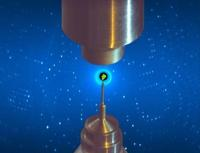Speaker
Description
Two influenza A nucleoprotein variants (wt: G102R; and mutant: G102R and E292G) were studied with regard to macro-molecular interactions in oligomeric form (24-mers). The E292G mutation has been previously shown to provide cold adaptation. Molecular dynamics simulations of these complexes and trajectory analysis showed that the most significant difference between the obtained models was distance differences between nucleoprotein complex strands. Influenza virus nucleoprotein complexes were isolated from strains bearing the corresponding NP amino acid substitutions. The isolated complexes were characterized by transmission electron microscopy and differential scanning fluorimetry (DSF). Presence of the E292G substitution was shown by DSF to affect nucleoprotein complex melting temperature. Using small-angle neutron scattering (SANS), the supramolecular structures of isolated complexes of these proteins was studied at temperatures of 15, 32, and 37°C. SANS data show that the structures of the studied complexes (mutant or normal proteins with RNA) at elevated temperature differ from the rod-like particle model and react differently to temperature changes. The data suggest that the mechanism behind cold adaptation with E292G is associated with a weakening of the interaction between strands of the ribonucleoprotein complex and, as a result, the appearance of inter-chain interface flexibility necessary for complex function at low temperature.

